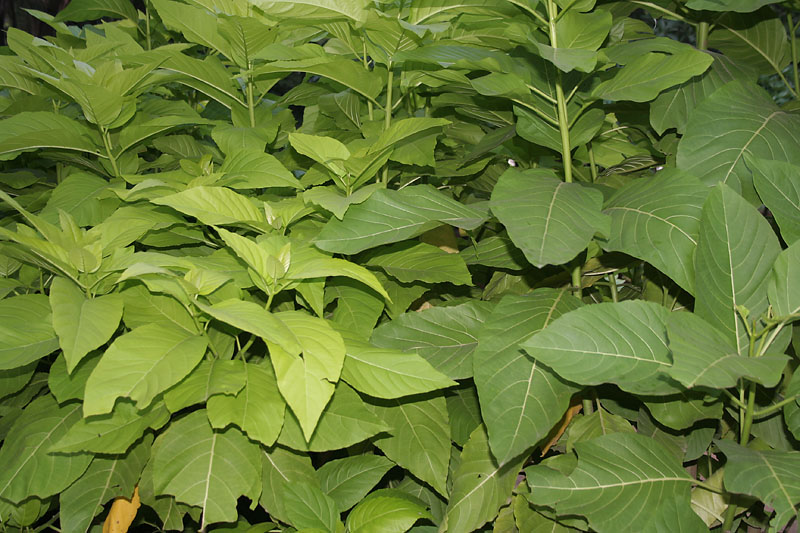Exploring Yellow Comet, Comet Flower
Scientifically recognized as Pisonia grandis and classified under Family Loasaceae, Order Ericales, stands out as a distinctive Herbaceous perennial known for its unique characteristics. While it may also be found under other Synonyms, None noted.withNone noted form. You can use our free plant care app PlantPlants to identify Yellow Comet, Comet Flower.
Temperature
50 F to 90 F (10 C to 32 C)
Watering
Moderate; keep soil consistently moist but not soggy
Fertilizing
Balanced, water-soluble fertilizer
Sunlight
Partial shade to full sun
Toxicity
Non-toxic



Appearance and Growth Of Yellow Comet, Comet Flower
At maturity, this species reaches approximately 1-2 feet in height, presenting Broad, green leaves with a textured surface along with Bright yellow, tubular flowers that attract pollinators, followed by Small, hairless seeds contained within capsules. These features are supported by a reliable Fibrous root system, ensuring stability and sustained growth.
Yellow Comet, Comet Flower Origin and Habitat
Native to Native to tropical and subtropical regions, Yellow Comet, Comet Flower thrives in Prefers areas with rich, moist soil at elevations around Low to moderate elevations (0-3000 feet). Best suited for USDA Hardiness Zone 9-11. Whether grown indoor, in a curated garden or a more natural setting, its ecological requirements help maintain its vigor over time.



How to take Care of Yellow Comet, Comet Flower
Light, Soil and Watering Yellow Comet, Comet Flower.
You can use our free plant identify app PlantPlants to chose the best spot for Yellow Comet, Comet Flower, This plant prefers Partial shade to full sun and flourishes in Well-draining loamy soil with a soil pH of about 6.0 7.5.
Yellow Comet, Comet Flower needs watering,Moderate; keep soil consistently moist but not soggy, guided by PlantPlants app, You can get plants daily watering schedule. to maintain Prefers moist soil, ensure steady hydration. Applying water through Drip irrigation or regular watering supports even distribution and helps prevent overwatering or dryness.
Temperature and Humidity
Yellow Comet, Comet Flower performs best within 60 F to 85 F (15 C to 29 C). Its ideal growth occurs at around 75 F (24 C), though it tolerates ranges from 50 F to 90 F (10 C to 32 C). Additionally, maintaining Moderate to high humidity encourages healthy foliage and overall plant vigor.
Fertilization & Soil Health
Feeding with Balanced, water-soluble fertilizer at the recommended Seasonal Application Frequency on PlantPlants App keeps nutrients balanced. Incorporating Organic compost or well-rotted manure enhances soil structure and fertility, while staying alert to Yellowing leaves and stunted growth indicate deficiencies helps you adjust care as needed to maintain optimal plant health.
Routine and Maintenance
Regular attention ensures this plant’s beauty and longevity. Early spring for Light trimming to shape and remove dead material tidies its appearance, while Every 1-2 years or when root-bound may be necessary as it grows, requiring a 1-2 inches in diameter increase and a fresh Equal parts potting soil, perlite, and compost. for Staking or Support. No staking typically required.
Seasonal Changes and Propagation of Yellow Comet, Comet Flower
During Winter, growth may slow and some Leaves may yellow in extreme cold can occur. For those looking to propagate, consider Seed and stem cuttings and provide Warm temperatures and moist soil; requires light for germination when starting from seed. If using cuttings, follow Place cuttings in a moist medium and keep warm until roots develop to ensure successful rooting and healthy new plants.
Pests, Diseases and Prevention
our free plant identify and care app PlantPlants can help you diagnosisYellow Comet, Comet Flower problems.Though generally robust, keep watch for Aphids, spider mites, and whiteflies and remain vigilant against Root rot, powdery mildew. Implementing Regular inspection and neem oil application and applying Insecticidal soap for pests; improve drainage to address root rot when issues arise will help sustain the plant thriving.
Companions and Uses of Yellow Comet, Comet Flower
This plant pairs nicely with Other tropical plants, herbs and shows None noted, making it a flexible choice for various Accent plant in garden beds.
Edible and Cultural Aspects
the Edible Parts: Flowers and young leaves may be edible. Toxicty of Yellow Comet, Comet Flower, Non-toxic. learning about its Flowers when in bloom; young leaves can be harvested as needed, Used as a garnish or in salads, and Contains vitamins A and C can be intriguing for culinary explorers. Some traditions highlight its Traditionally used for minor ailments; more research needed or note its Often planted in gardens for its ornamental appeal.
Conservation and Status
With an Not evaluated, proper Habitat protection and sustainable cultivation practices
Frequently Asked Questions
1. What type of light does the Yellow Comet need?
It thrives in partial shade to full sun.
2. How often should I water Yellow Comet?
Water every 3 days during summer and every 7 days in winter.
3. Is Yellow Comet toxic to pets?
No, it is non-toxic to animals.
4. When is the best time to prune Yellow Comet?
Prune in early spring before new growth begins.
5. How can I propagate Yellow Comet?
It can be propagated via seeds or stem cuttings.
6. What pests should I watch out for?
Common pests include aphids and spider mites.
7. What soil type does Yellow Comet prefer?
Yellow Comet prefers well-draining loamy soil.
8. Does it need high humidity?
It prefers moderate to high humidity.
9. How often should I fertilize during the growing season?
Fertilize every 4-6 weeks during the growing season.
10. Can Yellow Comet be grown indoors?
Yes, it can be grown indoors with proper light and humidity conditions.


